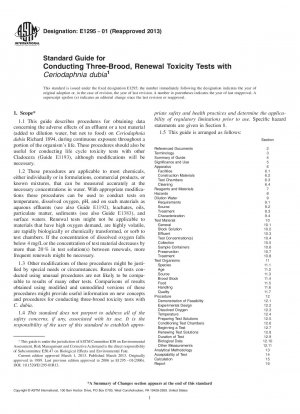ASTM E1295-01(2013)
Standard Guide for Conducting Three-Brood, Renewal Toxicity Tests with Ceriodaphnia dubia
- Standard No.
- ASTM E1295-01(2013)
- Release Date
- 2001
- Published By
- American Society for Testing and Materials (ASTM)
- Status
- Replace By
- ASTM E1295-22
- Latest
- ASTM E1295-22
- Scope
5.1 Ceriodaphnia was first used as a toxicity test organism by Mount and Norberg (4). Introduced for use in effluent and ambient water evaluations, Ceriodaphnia have also been a valuable addition to single chemical test procedures.
5.2 Protection of a population requires prevention of unacceptable effects on the number, weight, health, and uses of the individuals of that species, or species for which the test species serves as a surrogate. A three-brood toxicity test is conducted to help determine changes in survival and the number of neonates produced that result from exposure to the test material.
5.3 Results of three-brood toxicity tests with C. dubia might be used to predict chronic or partial chronic effects on species in field situations as a result of exposure under comparable conditions.
5.4 Results of three-brood toxicity tests with C. dubia might be compared with the chronic sensitivities of different species and the chronic toxicities of different materials, and to study the effects of various environmental factors on results of such tests.
5.5 Results of three-brood toxicity tests with C. dubia might be useful for predicting the results of chronic tests on the same test material with the same species in another water or with another species in the same or a different water. Most such predictions are based on the results of acute toxicity tests, and so the usefulness of the results of a three-brood toxicity test with C. dubia might be greatly increased by also reporting the results of an acute toxicity test (see Guides E729 and E1192) conducted under the same conditions. In addition to conducting an acute test with unfed C. dubia, it might also be desirable to conduct an acute test in which the organisms are fed the same as in the three-brood test, to see if the presence of that concentration of that food affects the results of the acute test and the acute chronic ratio (see 10.4.1).
5.5.1 A 48 or 96-h EC50 or LC50 can sometimes be obtained from a three-brood toxicity test with a known test material, but often all the concentrations in the test will be below the EC50 or LC50. In addition, it is usually desirable to know the EC50 or LC50 before beginning the three-brood test, as a means to determine the concentrations for use in the chronic test (see 10.4.1). It should be noted that results from an acute test may not necessarily correspond to those of a chronic test, due to the addition of food to the chronic test.
5.6 Three-brood toxicity tests with C. du......
ASTM E1295-01(2013) Referenced Document
- ASTM D1193 Standard Specification for Reagent Water
- ASTM D3978 Standard Practice for Algal Growth Potential Testing with Selenastrum Capricornutum
- ASTM E1023 Standard Guide for Assessing the Hazard of a Material to Aquatic Organisms and Their Uses
- ASTM E1192 Standard Guide for Conducting Acute Toxicity Tests on Aqueous Ambient Samples and Effluents with Fishes, Macroinvertebrates, and Amphibians
- ASTM E1193 Standard Guide for Conducting
Daphnia magna Life-Cycle Toxicity Tests - ASTM E1383
- ASTM E1706 Standard Test Method for Measuring the Toxicity of Sediment-Associated Contaminants with Freshwater Invertebrates
- ASTM E729 Standard Guide for Conducting Acute Toxicity Tests on Test Materials with Fishes, Macroinvertebrates, and Amphibians
- ASTM E943 Standard Terminology Relating to Biological Effects and Environmental Fate
- IEEE/ASTM SI 10 American National Standard for Metric Practice
ASTM E1295-01(2013) history
- 2022 ASTM E1295-22 Standard Guide for Conducting Three-Brood, Renewal Toxicity Tests with
Ceriodaphnia dubia - 2001 ASTM E1295-01(2013) Standard Guide for Conducting Three-Brood, Renewal Toxicity Tests with
Ceriodaphnia dubia - 2001 ASTM E1295-01(2006) Standard Guide for Conducting Three-Brood, Renewal Toxicity Tests with Ceriodaphnia dubia
- 2001 ASTM E1295-01 Standard Guide for Conducting Three-Brood, Renewal Toxicity Tests with Ceriodaphnia dubia
- 1989 ASTM E1295-89(1995) Standard Guide for Conducting Three-Brood, Renewal Toxicity Tests with Ceriodaphnia dubia

Copyright ©2024 All Rights Reserved